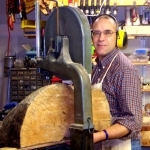I used the dried yellow glue and ironing method to bond an expensive maple burl to a small table top. Finished it with three coats of homemade oil/varnish and then two coats of water based polyurethane (minwax). Now there are several bubbles randomly scattered where the veneer is apparently delaminating! This started after the second coat of Minwax. Do you think I can rebond it with more heat and pressure from an iron or am I doomed to start over???
Thanks for ANY help….
















Replies
Well, you have to try rebonding with heat, but the waterborn finish may well not survive. Just sneak up on the heat and keep fingers crossed.
Oil/varnish doesn't provide much moisture protection. Consequently, the waterborne finish may have led to enough swelling of the veneer to create delamination.
Thanks for your reply.
Next time should I first seal it with shellac?
Why not just continue the finish with an oil varnish wipeon instead of waterbase?Gretchen
I like Gretchen's response. Wood and water aren't best of friends and veneer is particularly susceptible to moisture problems.
A sealer of shellac may well work, but it is complicating the schedule, and even though the water borne finish will adhere to shellac--as long as it is dewaxed shellac it's usually better to continue using materials that are more similar in characteristics.
I'm not sure if more heat and pressure would work. I've had a very few bubbles in veneer that were discovered after the finish was applied and when reattached, there was in some cases a slight depression where the bubble had been. I presume this was from, either the sanding had removed more wood from the bubble, during the initial finishing process; or applying the concentrated heat and pressure in one area, left the depression.
I think the problem is more related to the iron on veneer method. I've not tried it myself, but I've heard of quite random results. My own experience with PVA glue and a press, varied from acceptable to disastrous. The disastrous result was with piece of burl veneer. I don't believe most PVA glues have the "body" to establish a sufficient bond, especially in a highly figured burl veneer ( at least not without having a tremendous amount of bleed through).
I switched to hammer veneering with hot hide glue, and my veneer work instantly became predictable and hassle free.
Rob Millard
http://www.americanfederalperiod.com
You may want to try to put a little slice with a very sharp razor, one with a blade that is new and been stroped on pc. of leather with rouge or some kind of fine compond rubed on it to remove the factory burr, remember to slice at a low angle,lift gently up slightly and put some super glue in the bubble,press buy wiping with a clean cloth and keep the cloth moving. good luck! I have had good success with this way in the past. P.S. next time try hide glue its more forgiven, and whatever you do don't use a solvent glue with a solvent finish!. and again good luck!!!!!!!.
This forum post is now archived. Commenting has been disabled